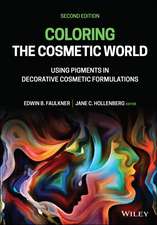Global Regulatory Issues for the Cosmetics Industry: Personal Care and Cosmetic Technology
Autor C.E. Bettonen Limba Engleză Hardback – 10 aug 2007
Preț: 648.30 lei
Preț vechi: 712.41 lei
-9% Nou
Puncte Express: 972
Preț estimativ în valută:
124.07€ • 134.72$ • 104.22£
124.07€ • 134.72$ • 104.22£
Carte tipărită la comandă
Livrare economică 16-30 aprilie
Preluare comenzi: 021 569.72.76
Specificații
ISBN-13: 9780815515678
ISBN-10: 0815515677
Pagini: 232
Dimensiuni: 152 x 229 x 17 mm
Greutate: 0.51 kg
Editura: ELSEVIER SCIENCE
Seria Personal Care and Cosmetic Technology
ISBN-10: 0815515677
Pagini: 232
Dimensiuni: 152 x 229 x 17 mm
Greutate: 0.51 kg
Editura: ELSEVIER SCIENCE
Seria Personal Care and Cosmetic Technology
Cuprins
Contributors Preface Introduction 1 Risk Assessment and Cosmetics 1.1 Introduction: Risk Perception and Regulation 1.2 Risk and Cosmetics 1.3 The Risk Assessment Process 1.3.1 Regulations 1.3.2 Role of the Safety Assessor 1.3.3 Guidance 1.3.4 Safety Assessment 1.3.5 Assessment Contents 1.3.6 Other Tests 1.4 Conclusion References 2 Regulatory Developments in Canada, Japan, Australia, China, and India 2.1 Introduction 2.2 Canada 2.3 Japan 2.4 Australia 2.5 China 2.6 India 2.7 Trade Alliances 2.8 California 2.9 Conclusion 3 The REACH Regulation of the European Union 3.1 Introduction 3.2 Why REACH? 3.3 REACH: Overview 3.4 REACH: Aims 3.4.1 Pre-registration 3.4.2 Substance Information Exchange Fora (SIEF) 3.5 Exemptions: Cosmetics? 3.6 Registration References 4 REACH: An Example of the New Paradigm in Global Product Regulation 4.1 Introduction 4.2 REACH: "No Data, No Market" 4.2.1 What is REACH? 4.2.2 How Does REACH Affect the Cosmetics Industry? 4.2.3 How Will REACH Work? 4.3 What Should Companies Be Doing Now? References 5 Developing a Global Regulatory Strategy: Leveraging Local Knowledge to Drive Rapid Market Entry 5.1 Introduction 5.2 Globalization: "One Size Does Not Fit All!" 5.3 Using Regulatory Compliance for Competitive Advantage 5.3.1 Organizational Design 5.3.2 Targeted Capability 5.3.3 Local Knowledge 5.3.4 Business Engagement 5.3.5 Cross-Functional Processes, Systems, and Tools 5.3.6 Communication Plan 5.4 The Global Launch: "Driving with Insights and Regulations" 5.5 Conclusions 6 Cosmetics: Toxicity and Regulatory Requirements in the US 6.1 Introduction 6.2 Regulatory Requirements for Cosmetics 6.2.1 Warning Statement 6.2.2 Ingredient Declaration 6.3 California Proposition 65 and California Safe Cosmetics Act of 2005 6.4 EU Cosmetics Regulation 6.5 The Future of Cosmetics Regulatory Requirements 7 Restricted Substances in Consumer Products: The Challenge of Global Chemical Compliance 7.1 Introduction 7.2 Addressing the Challenges of Emerging Globally Restricted Substances Regulations 7.3 Restricted Substances: Strategy Definition 7.3.1 Steps to Meeting Global Compliance Directives 7.4 Best Practices 7.5 Recommendation and Conclusions 8 In Vitro Toxicology for Cosmetics: Regulatory Requirements, Biological Limitations 8.1 Introduction 8.2 EU Cosmetic Legislation and Animal Testing 8.3 A Viable Timeline? 8.4 Acute Toxicity 8.5 Skin Corrosion 8.6 Skin Irritation 8.7 Eye Irritation 8.8 Skin Sensitization 8.9 Carcinogenicity 8.10 Reproductive/Developmental Toxicity 8.11 Toxicokinetics 8.11.1 Absorption 8.11.2 Distribution 8.11.3 Metabolism 8.11.4 Excretion 8.11.5 Toxicokinetics 8.12 Other Considerations 8.13 Conclusions References 9 Nanotechnology and Nanomaterial Personal Care Products: Necessary Oversight and Recommendations 9.1 Introduction 9.2 What is Nanotechnology Anyway? A New World of Tiny Technology 9.2.1 Nano Means Fundamentally Different 9.2.2 Manufactured and Engineered Nanomaterials vs. Natural Nanoparticles 9.2.3 The Next Industrial Revolution? The Stages of Nanotechnology's Predicted Development 9.3 Nanomaterials in Consumer Products: The Future is Now 9.3.1 Measures of Nanotechnology’s Maturation 9.4 What are the Human Health Risks of Nanotechnology and Nanomaterials in Personal Care Products? 9.4.1 Nanotoxicity 9.4.2 Unprecedented Mobility 9.4.3 The Public at Large 9.4.4 The Question of Skin Penetration 9.4.5 Nanomaterial Worker and Workplace Risks 9.5 What are the Environmental Risks of Nanotechnology and Nanomaterials in Personal Care Products? 9.5.1 Huge EHS Unknowns 9.6 FDA’s Regulatory Stance on Nanotechnology and Nanomaterial Personal Care Products 9.7 Nanotoxicology: Nano-specific Testing Paradigms Are Required 9.8 Nanomaterial Oversight Developments from FDA 9.9 Conclusions and Recommendations for Government and Industry 9.9.1 Support Much More Vigorous EHS Research 9.9.2 Acknowledge the Unknowns and Fundamental Differences of Nanomaterials and Act Accordingly 9.9.3 Prepare to Meet the EU Standards: The Burden of Proof is on Industry 9.9.4 Transparency 9.9.5 Repeating Past Mistakes: Running From Your Product's Label is Not a Business Plan 9.9.6 Lifecycle 9.9.7 See the Big Picture: The Question is Not if, But When 9.9.8 Learn from the Past References 10 Navigating the Turbulent Waters of Global Colorant Regulations for Packaging 10.1 Introduction 10.1.1 Authors's Note 10.2 Definitions 10.2.1 United States 10.2.2 Canada 10.2.3 European Union 10.2.4 Asia 10.3 Regulations 10.3.1 United States 10.3.2 Canada 10.3.3 European Union 10.4 Choosing the Right Colorants for Your Product 10.4.1 Dyes 10.4.2 Pigments 10.4.3 FD&C Colorants 10.4.4 Migration 10.5 Meeting the Design Challenge 10.5.1 Risk Assessment 10.5.2 The Quandry of Non-Regulation Regulations 10.5.3 Allergens 10.5.4 Testing 10.6 Importing Packaging 10.6.1 Liability Issues 10.7 Regulations at a Glance Index






























